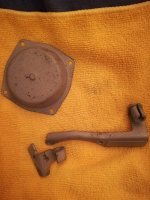Not too sure what you mean by aquablasting. If you mean vapor blasting (as it is commonly called in the US), a frame is mighty big for the cabinets I have seen. I personally don't want any moisture whatever involved in prepping bare steel. Dry glass beads are fine for small parts and with some dedication can produce parts nearly as nice as vapor blasting. Certainly you can sand or scotchbrite parts to a sufficiently smooth and rust free condition, but you guys must have some sort of bad-ass scotchbrite or some much finer abrasive than I typically see used for sandblasting! Regardless, I reckon the key point here is how long you expect the parts to last, i.e. how long before unattended to corrosion shows back up through the paint, and what you require as an acceptable finish in the first place. No doubt you can simply prime and paint your parts as is, and they will come up pretty good. If you want them to last a while, you need to get the majority of corrosion off first. If you want a 20+ year part, you will need to get ALL the rust removed and a fairly carefully prepped surface. You also need to consider the environment the parts will live in. Carburetor parts get handled a lot more than most parts on bikes, and get attacked by gasoline as well. That is why the manufacturer typically plates steel parts on carbs. Most people find chrome plating prohibitively expensive in the US, but that would certainly solve the problem (if you can find an acceptable plater!). Paint on carbs is really hard to make last unless you go to a fair amount of trouble and either use epoxy and/or urethane paint or powdercoat. Sometimes it is useful to look at the overall scope of the project to determine how much trouble you need to go to. If the project is a blank check or museum caliber job, obviously you spare no expense. Otherwise, small parts like these can be "good enough" with a "90% of the effect for 10% of the trouble" approach. If those parts were mine and I was putting them on a bike I was going to use, I'd sand them, spray them with converter-primer, and paint them and bake them to make the paint as durable as possible. I'd live with the results and touch them up if they start to suffer. Down the road, you can always take them up to a higher level if you can't live with them.





